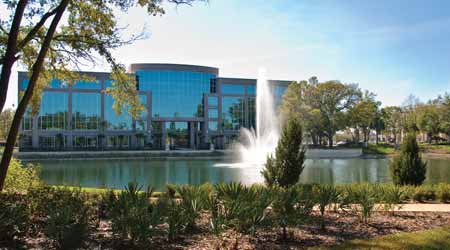 Limiting turf area to 25 percent or less of the vegetated area is one option for earning the Site Management credit in LEED v4.
Limiting turf area to 25 percent or less of the vegetated area is one option for earning the Site Management credit in LEED v4.Changes To Advanced Energy Metering, Demand Response Prioritize Energy Effeciency in LEED v4
Second of a two-part article detailing the updates to the LEED v4 Operations and Maintenance Existing Buildings rating system.
Energy efficiency is a huge area of focus in LEED v4. Two ways that focus is prioritized is advanced energy metering and demand response. As well, credits for purchasing and waste policy have been combined to create a new stronger prequisite, and three indoor air quality credits have been streamlined into one.
Advanced energy metering (1-2 points). This new credit incorporates topics from the LEED 2009 Minimum Program Requirement 6 and the Performance Measurement — System Level Metering credit. To fulfill this credit, the project must install advanced meters for:
• All whole-building energy sources used by the building and
• Major end uses that account for 20 percent or more of the total annual consumption of the building (minus plug load).
Projects that achieve this credit are rewarded for going above the guidelines set by the Building-Level Energy Metering prerequisite.
Demand response (1-3 points). Introduced in 2010 as a pilot credit, this credit rewards projects that participate in automated demand response programs. Projects achieve this credit by:
• Participating in an existing demand response program,
• Putting the infrastructure in place to take advantage of future demand response programs or dynamic, real-time pricing programs (if no existing program is available), or
• Implementing measures to shift peak loads to off-peak hours that demonstrate a 10 percent or greater reduction in peak demand.
Demand response has great potential to enhance efficiency in power distribution systems, especially for areas with a high concentration of commercial and industrial buildings. Projects that achieve this credit support technologies and programs that help reduce overall demand for electricity, increase grid reliability, and cut greenhouse gas emissions.
Ongoing purchasing and waste policy (prerequisite). This new credit combines two prerequisites from v2009: MR Prerequisite Sustainable Purchasing Policy and MR Prerequisite Solid Waste Management Policy. It also includes additional requirements from v2009 of MR Credit Waste Stream Audit, as well as minimum recyclable storage requirements to align with the prerequisite requirement in the Building Design and Construction (BD+C) rating systems. Projects are rewarded for taking steps to reduce environmental harm from materials purchased, used, and disposed of during building operation. To achieve this credit, projects must:
• Have an environmentally preferable purchasing policy for products purchased during regular building operations that include ongoing and durable good purchases.
• Have storage locations for recyclable materials: mixed paper, corrugated cardboard, glass, plastics, and metals.
• Have an established environmentally preferable solid waste management policy that addresses reuse, recycling, or composting of products purchased during regular building operations.
The prerequisite includes additional guidance and options for retail projects to promote environmentally responsible sourcing of retail merchandise.
Enhanced indoor air quality strategies (1-2 credits). This new credit combined portions of three v2009 credits (IAQ 1.2 Indoor Air Quality Best Management Practices — Outdoor Air Delivery Monitoring, 1.4 Indoor Air Quality Best Management Practices — Reduce Air Particulates in Air Distribution, and 3.5 Green Cleaning — Indoor Chemical and Pollutant Source Control.) Along with providing streamlined guidance, the scope was expanded to include different space types, including warehouses and distribution centers.
Projects can achieve this credit by establishing and maintaining entryway systems designed to capture dirt and particulates; or by following other IAQ strategies, like installing filtration for mechanically and naturally ventilated spaces, installing carbon dioxide monitors in densely populated spaces, or conducting outdoor air monitoring for naturally and mechanically ventilated spaces.
Projects that fulfill this credit are rewarded for going above and beyond the requirements set by the Minimum Indoor Air Quality Performance prerequisite.
By establishing effective indoor air quality best management practices, facility managers promote occupant comfort, well being and productivity. n
Amanda Sawit is a content specialist with the U.S. Green Building Council.
Email comments and questions to edward.sullivan@tradepress.com.
Related Topics:













